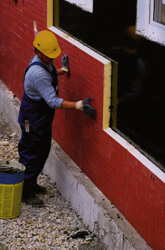Buildings currently waste a large proportion of the energy that goes into them. This energy heats up the earth instead of our homes, wastes money and increases our dependence on foreign energy supply. The estimated 160 million buildings in Europe, for example, account for more than 40% of the European Union’s energy consumption and 36% of our CO2 emissions. Finding ways of lowering the carbon footprint of buildings is therefore all the more vital.
The most important application of polyurethanes in buildings is insulation. Polyurethanes are regarded as an affordable, durable and safe way of reducing carbon emissions that lead to global warming. Polyurethanes can dramatically reduce heat loss in homes and offices in cold weather. During the summer, they play an important role in keeping buildings cool, which means air conditioning is needed less.


